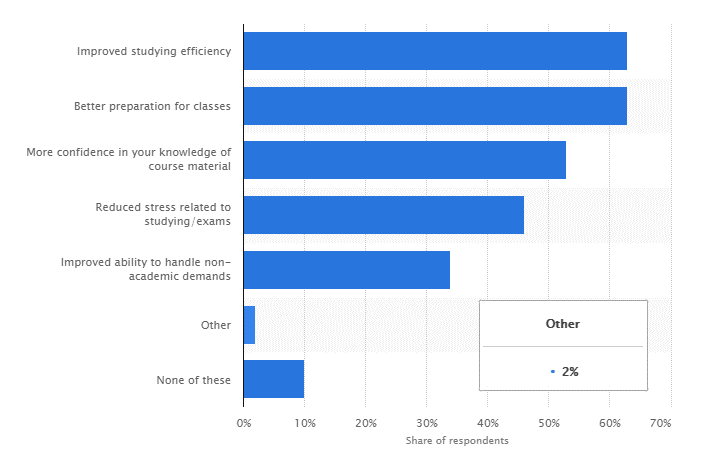The worldwide edtech market is expected to increase from its 2021 valuation of US$74.2 Bn to US$288.4 Bn by 2031, representing a compound annual growth rate (CAGR) of 14.5%. So, if you plan to launch an edtech startup, this is the right time to give it a thumbs up.
The growth of the edtech market is being fueled by various factors, including the increasing number of edtech companies, the flourishing mobile learning industry, and the growing scope of the digital learning market.
With the growth of emerging edtech tools, students can strengthen their understanding of key topics using such tools. If you look at the Graph below, you’ll see that today’s students are more aligned toward or believing the potential of their education technology.

Here you can see what the data says about the edtech industry.

According to some industry experts, It’s intended that 2023 would be a breakthrough year for industry startups. When the ‘profitable growth’ thesis begins to take shape and new models become entrenched in 2023; investors will cautiously increase their bets on the sector.
If we go back 2 years, i.e., 2020-2021, this was a golden time for Edtech Industries. After the arrival of Covid-19, when schools and colleges were closed, and a new era started where every child was taking online education instead of offline, the same tech industries were bringing different tools into the market to strengthen online education. And due to these experiments, many new ideas were generated, and the Edtech industry got new recognition.
Now if we talk about 2023, things have started becoming normal; schools and colleges have opened, and children are again divided into online and offline education.
Read more: How to Launch an Online Course that Sells
On the other hand, if we consider how far technology has come, we can see that it is now in a very powerful position. These days, students have very high expectations from the edtech industry because they believe it has much untapped potential. And if you begin Edech in this manner, you will find that it is to your massive advantage in the long run.
Why Launch an Edtech Startup?
The Graph below will show the strongest reason to launch an Edtech startup.

The practical reasons to launch an edtech startup:
1. It is the centre of attraction for Generation Z.
Education has been a significant advantage for generations. Some communities still lack adequate educational opportunities even though they live in the modern world. When it comes to educational technology, today’s youth have high hopes. Because of the innovations in the education sector, students may now study from virtually anywhere in the country and yet have access to the same high-quality education. Students may gain a thorough understanding of any topic without ever having stepped into a classroom, all thanks to Edech Tools and Software.
2. It attracts Investors
Current patterns show that investors are greatly interested in the education technology sector. 2021 and 2022 were the best years to invest in edtech. But the end of 2022 showed a slowdown. But as per the reports, Over 70% of colleges expect to launch one or more online undergraduate programs in the next three years. So, you need to think out of the box to serve the edtech market. If a business investor thinks your idea has potential, they will fund your edtech startup. There is a possibility of receiving guidance from established businesspeople, introductions to additional investors, and other benefits if you can secure investor finance.
3. The low initial investment, low risk
Launching an edtech startup is on the more affordable side these days. With the advent of technology and greater availability of open source and extremely viable outsourced partners, the initial investment in an edtech startup is very low. Unlike 10 years ago, creating a business website and developing software is easy. It is now possible to create an e-learning website at a savings of between 20 and 50 per cent. Besides, social media platforms enable startups to easily edit, republish, and distribute Ebooks to a large audience without incurring major additional expenditures.
4. Increased interest and demand
By 2026, the K-12 education market is projected to rise by as much as 25 per cent. After the pandemic, higher education institutions are beginning to recognize the value of online education. It helps save money and opens enrollment to a wider audience of potential students worldwide. The number of high-tech gadgets and people who know how to use them effectively is rising. Parental participation in their children’s education increases as more and more schools adopt and use digital tools. This indicates there are more options for family-based education.
Edtech Business models
To understand the scope and complexity of edtech market understanding the business models can bring some help. It helps you see clearly how to choose the best revenue source for your company. Knowing what value to provide and who will pay the value is crucial. Following are the various business models of edtech. For more pros and cons in deeper, you can click on the following link
Read more: Pros and Cons of Famous Edtech Business Models
Freemium
Of all the edtech business models, freemium is among the most advantageous. It’s more akin to offering a free sample of your goods or services before charging extra for an exclusive and expensive one.
But why do so many startups choose this framework?
The answer is straightforward: it’s the most sincere method of fostering consumer loyalty and product virality. The freemium approach does, however, come with some financial risk.
Subscription-based model
The difference between this model and the freemium model is that the full range of services is only free for a certain period before the user must pay to continue using the services. The majority of real consumers become customers by the trial’s conclusion.
The concept is appropriate for two categories: content delivery and services.
Sponsored Model
Although this business model is not well known, edtech companies frequently adopt it because neither parents nor schools are required to pay. Even yet, businesses that want to advertise their goods or services invest money to get in front of the right people, such as students and teachers.
They can learn important information about the education market as a result. These initiatives fall under the umbrella of corporate social responsibility. A government grant may occasionally be provided if the goal is to aid the general public.
Edtech Market Place
Like a stock market, an edtech marketplace business strategy often entails building a platform that links teachers, trainers, and students with edtech solutions, courses, and materials.
In either a B2B or B2C scenario, instructors and trainers can present their programs and services, and students can look for and sign up for the programs they require.
Advertising, subscription fees, and course purchase commissions are the main income sources. All parties involved in the education sector and income creation will have access to a practical solution.
Top-down model
The top-down model, also known as the institutional model, is where businesses target educational institutions as their primary clients and offer a wide range of technology-based products and services to assist the teaching and learning process. In the case of SimpleLearn, the target is the business. These businesses offer support and professional development programs to aid teachers in successfully integrating technology into their lesson plans.
Bottom-up model
Consumers are the focus of the bottom-up company strategy, which makes money when customers are satisfied. Although the model is B2C, the operations are B2B. Parents pay to utilise it if they’d like, but the school/college receives a free product in exchange for promoting it to the kids.
Conclusion
So, this edtech startup guide will be an invaluable resource for anyone considering the same. In this valuable blog post, also known as the Edtech Startup Guide–Part 1, we laid the groundwork for your venture’s debut and the initial areas of attention. The next blog post will discuss the steps to launch a successful startup. Till then, keep your road map ready by following the initial steps.
Good Luck..!!




